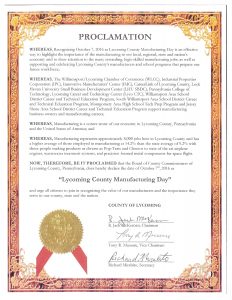Once largely focused on large manufacturers, EWI is broadening the scope of its research and engineering efforts to also help small-to-mid size manufacturing firms put advanced technologies on the shop floor.
(IW – Steve Minter: 10-30-16) “We’re all optimists here,” says Henry Cialone, the president and CEO of engineering and technology organization EWI, referring to his team of more than 160 engineers, technicians and other experts.
One would expect optimism from the leader of any company but it may be especially valuable at EWI, which is dedicated to helping manufacturers benefit from innovative technologies. That pursuit of innovation necessarily involves failure and that can be a tough concept for any group of highly trained professionals to accept.
“That is probably the biggest challenge because we have an expert culture. People don’t want to be wrong,” Cialone observes. “They don’t want to have to say they need help.”
But since joining EWI in 2005, one of Cialone’s objectives has been to mold a culture of smart people who are willing to take risks and accept failure as a step toward success.
“What I encourage my people to do is be troublemakers. People find that odd – how do you run a business if it’s okay to cause trouble. But if they’re not unruly, they’re not going to change the world and I want my people to change the world, at least the world of manufacturing,” he says. “I’m not saying be obnoxious or be abusive. Come up with the occasional crazy idea. Try it out. It might work.”
That combination of expertise in a broad range of disciplines and the willingness to try new things has helped fuel EWI’s growth over the past decade. EWI began in 1984 as the Edison Welding Institute in Columbus, Ohio, one of a group of state-funded technology centers. Today, the non-profit company no longer receives state funding and, unlike many R&D organizations, is focused on helping commercial customers, a part of the business that is growing at a 15% annual rate.
EWI also has expanded its footprint with two other laboratories in Buffalo, N.Y. and Loveland, Colo. EWI is considering adding another site in Phoenix. Cialone said these new facilities allow it to be closer to more customers, an important consideration in a custom business where it is critical to understand what a manufacturer is trying to accomplish.
“We hone in on an idea and then put together a proposal,” says Cialone. “The closer you are, the more feasible it is to do that more often.”
The direction of EWI Colorado illustrates how far EWI has come from its roots in welding. The new facility, which will have its opening on November 9, is focused on advanced quality measurement technologies. The lab will have capabilities in real-time manufacturing process monitoring and analysis, advanced nondestructive (NDE) evaluation, computer vision inspection, non-contact metrology and structural health monitoring.
Over the years, says Cialone, “We’ve added a lot of other technologies. We still do welding but we do machining and forming and robotics and inspection and 3D printing. Anything that a manufacturer does, we are probably involved in it.”
For example, the paint on airplanes periodically has to be stripped in order for the plane to be inspected. The paint stripping traditionally was done with either a solvent, which is environmentally toxic, or with plastic pellets or with sanding. EWI developed a high-power laser scanner for paint stripping applications. The laser system is precise enough that it can stop at the primer or strip the paint down to the substrate.
“We take a laser and raster it across the surface. When it hits the atmosphere, the paint combusts and all you have is a little ash to dispose of,” Cialone explains.
To keep at the forefront of technology, EWI needs to hire and retain talented technologists. Doing so is a challenge, Cialone admits. He says the company offers competitive pay but that is not a primary motivator for the people EWI wants to attract.
“People want autonomy. They want a sense of purpose,” says Cialone. “We think our mission has a sense of purpose to it – to shape the future of manufacturing.”
The diversity of the work is also attractive to employees, Cialone posits.
“They like the fact that they have so many different activities going on at any given time. We have customers in every manufacturing sector from snack foods on up to commercial spaceships. Talk about diversity – you have to have a certain amount of ADD to work in our place,” he quips.
Help for Smaller Manufacturers
EWI traditionally has worked with larger manufacturers, whose technical experts would seek them out for help with a problem where EWI’s expertise was recognized. Cialone said he once thought small-to-mid-size firms could not afford EWI’s services but came to recognize that was not the case. As a result, EWI recently set up a service for smaller firms called Advanced Manufacturing Implementation Strategy.
“It is a consultative advisory service – a little bit of management consulting and a little bit of technology coming together,” Cialone explains. “We’ll walk into a small to medium manufacturer, understand their business, understand their product set, understand their customers and the demands of the customers, and suggest places where technology could differentiate them, either by making them more efficient or providing faster turnaround or better product quality or all of the above.”
Cialone says smaller manufacturers need more help with new technologies because of the increasing dynamism in the industrial sector. Large OEMs are facing demands for faster product development in the market. Since many of them largely assemble products from supply chains of smaller manufacturers, they are passing those pressures down the line and, says Cialone, often leaving smaller firms to figure out how to cope on their own.
“Think about the businesses that no longer exist that were rocking and rolling 5 years ago. While manufacturing is not quite that crazy, it is moving in that direction,” Cialone observes. “Shorter product cycles, increasing demand for typically quality but also performance as well so they are now having to deal with different design approaches, different materials and different manufacturing methods.”
What are manufacturers looking for help with? While that differs somewhat by industry, Cialone said there is a broad interest in automation. That is being spurred by robots that can be used in close proximity with workers. While smaller firms want to incorporate these “cobots,” Cialone says they don’t necessarily have the expertise to evaluate them or the ability to shut down production while they test out a new robot.
“So for them, we have set up a factory automation pilot – come to our lab, we have a gazillion robots and different types of automation equipment. We’ll lay it out with you in our shop,” Cialone explains. “You can do the one-off here and then we’ll rapidly implement it in your shop without any false steps.”
With its expertise in joining and forming materials, EWI has been helping automotive manufacturers cope with the twin challenges of lightweighting vehicles – reducing their weight to comply with higher CAFÉ mileage standards while also maintaining structural safety. Cialone notes that automakers have been experimenting with a variety of new materials – – high-strength steels, aluminum, magnesium and combinations of these materials. Working with these new materials presents challenges from stamping them to joining different materials.
When EWI surveyed its customers about technical challenges facing them, automotive firms mentioned nondestructive testing as their top issue. That concern was prompted by the move to high-strength steels.
Automakers used to be able to test a spot weld with a screwdriver and hammer, Cialone noted. They would shove the screwdriver between two plates of steel, tap it and if it was a bad weld, it would break. If it was a good weld, it would be fine.
“It doesn’t work that way anymore. With the higher strength steels, they’re so strong you can’t iron the wrinkle back out,” Cialone says. EWI took medical imaging technology, upped the power levels and changed the underlying algorithms to work with the new steels. The result was a nondestructive way to test the welds.
Seeking a Package Deal
While EWI largely works on the basis that customers own any intellectual property arising out of their projects, the company has been moving into some commercialization and seeking to license its IP. That arose, says Cialone, out of customers questioning how they were going to implement new technology solutions.
“Some of our customers said, ‘We like working with you guys but if your project succeeds and you have invented a new way to do something, we’ll need to buy a new machine to do that and we’re dead in the water for 12 months or 18 months. We’re not going to do the project. If you can help us by producing some prototypes, we can test while we’re waiting for our machine.’ We started doing that.”
EWI has spun out a handful of projects. In 2014, EWI sold a live arc welding training system and the associated IP it had developed, RealWeld Systems Inc., to Lincoln Electric.
At the time, Cialone said “We are thrilled that Lincoln Electric shares our vision for the RealWeld Trainer in its ability to educate and deliver skilled, production-ready welders for the manufacturing workforce.”
The transaction was important for EWI, Cialone says. “We couldn’t get anybody to license it when we first put it together. Nobody took it seriously because we didn’t have a track record of commercializing IP.” But after Lincoln Electric purchased the technology, he says, “It changed our profile in the market. People view us differently now, as more serious developers of technology.”
Packaging is another area where EWI is seeking to profit from its IP. The company has developed an ultrasonic sealing technology it calls SonicSeal. Snack packages typically are filled from a gravity-fed hopper and the bags are heat-sealed. The seal won’t work if there is grease or salt in the way, so the bag is made large enough that the product dropping into it is clear of the sealing area. This leaves a tab of excess material.
EWI set a goal of reducing the material in the tab by 50% to 75% and began experimenting with the ultrasonic technology. EWI tested the technology with a major food manufacturer and produced 5 million packages. The SonicSeal packages used 8% less material and achieved a 40% reduction in the scrap rate. The packages provided 10% more efficient shelf space at retailers and can extend product shelf life by up to 4 weeks.
EWI has been in discussions with packaging machine manufacturers about the new technology and showcased it at the PackExpo show in Chicago last Nov. 6-9.
“I think this is going to revolutionize food packaging,” Cialone predicts.

